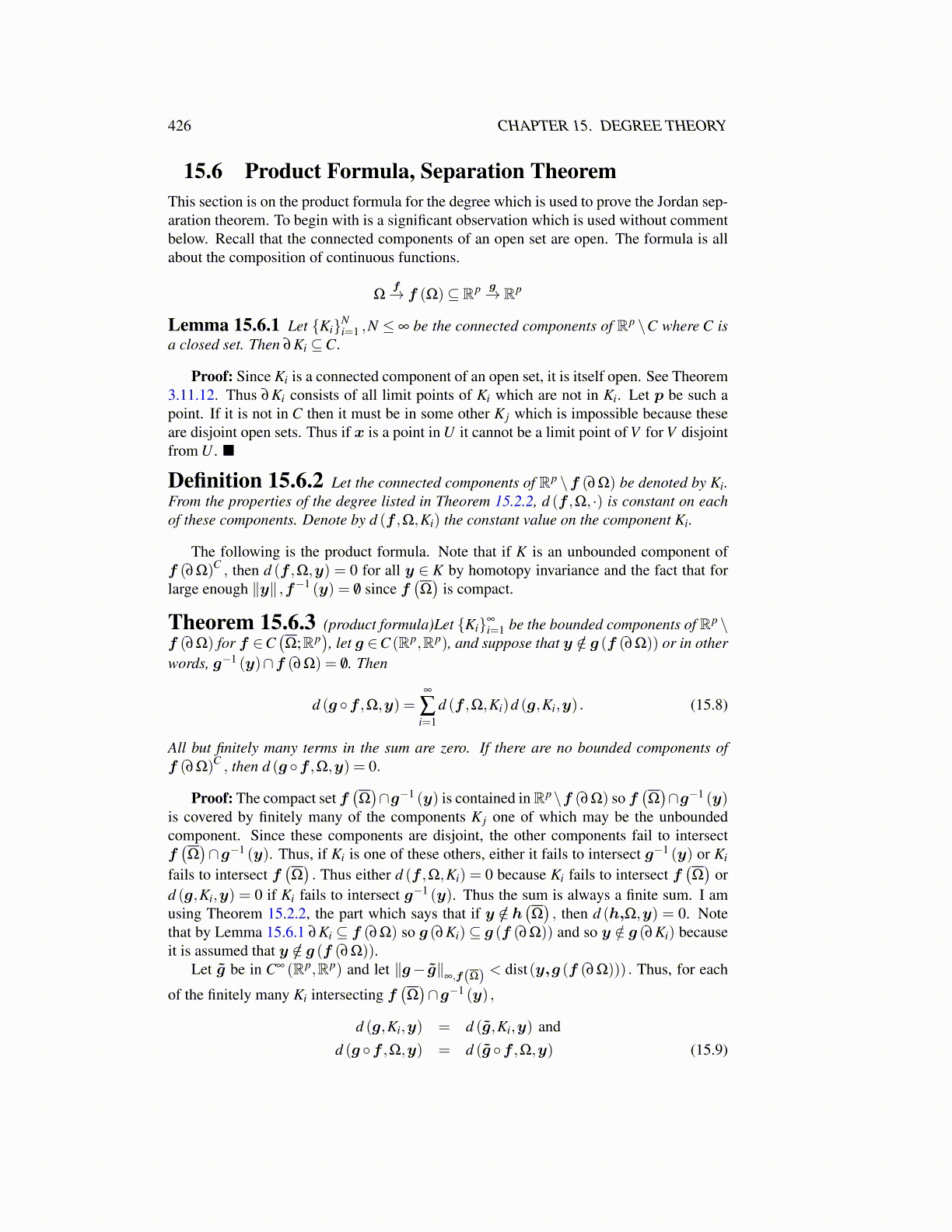
426 CHAPTER 15. DEGREE THEORY
15.6 Product Formula, Separation TheoremThis section is on the product formula for the degree which is used to prove the Jordan sep-aration theorem. To begin with is a significant observation which is used without commentbelow. Recall that the connected components of an open set are open. The formula is allabout the composition of continuous functions.
Ωf→ f (Ω)⊆ Rp g→ Rp
Lemma 15.6.1 Let {Ki}Ni=1 ,N ≤ ∞ be the connected components of Rp \C where C is
a closed set. Then ∂Ki ⊆C.
Proof: Since Ki is a connected component of an open set, it is itself open. See Theorem3.11.12. Thus ∂Ki consists of all limit points of Ki which are not in Ki. Let p be such apoint. If it is not in C then it must be in some other K j which is impossible because theseare disjoint open sets. Thus if x is a point in U it cannot be a limit point of V for V disjointfrom U . ■
Definition 15.6.2 Let the connected components of Rp \f (∂Ω) be denoted by Ki.From the properties of the degree listed in Theorem 15.2.2, d (f ,Ω, ·) is constant on eachof these components. Denote by d (f ,Ω,Ki) the constant value on the component Ki.
The following is the product formula. Note that if K is an unbounded component off (∂Ω)C , then d (f ,Ω,y) = 0 for all y ∈ K by homotopy invariance and the fact that forlarge enough ∥y∥ ,f−1 (y) = /0 since f
(Ω)
is compact.
Theorem 15.6.3 (product formula)Let {Ki}∞
i=1 be the bounded components of Rp \f (∂Ω) for f ∈C
(Ω;Rp
), let g ∈C (Rp,Rp), and suppose that y /∈ g (f (∂Ω)) or in other
words, g−1 (y)∩f (∂Ω) = /0. Then
d (g ◦f ,Ω,y) =∞
∑i=1
d (f ,Ω,Ki)d (g,Ki,y) . (15.8)
All but finitely many terms in the sum are zero. If there are no bounded components off (∂Ω)C , then d (g ◦f ,Ω,y) = 0.
Proof: The compact set f(Ω)∩g−1 (y) is contained inRp\f (∂Ω) so f
(Ω)∩g−1 (y)
is covered by finitely many of the components K j one of which may be the unboundedcomponent. Since these components are disjoint, the other components fail to intersectf(Ω)∩g−1 (y). Thus, if Ki is one of these others, either it fails to intersect g−1 (y) or Ki
fails to intersect f(Ω). Thus either d (f ,Ω,Ki) = 0 because Ki fails to intersect f
(Ω)
ord (g,Ki,y) = 0 if Ki fails to intersect g−1 (y). Thus the sum is always a finite sum. I amusing Theorem 15.2.2, the part which says that if y /∈ h
(Ω), then d (h,Ω,y) = 0. Note
that by Lemma 15.6.1 ∂Ki ⊆ f (∂Ω) so g (∂Ki)⊆ g (f (∂Ω)) and so y /∈ g (∂Ki) becauseit is assumed that y /∈ g (f (∂Ω)).
Let g̃ be in C∞ (Rp,Rp) and let ∥g− g̃∥∞,f(Ω) < dist(y,g (f (∂Ω))) . Thus, for each
of the finitely many Ki intersecting f(Ω)∩g−1 (y) ,
d (g,Ki,y) = d (g̃,Ki,y) andd (g ◦f ,Ω,y) = d (g̃ ◦f ,Ω,y) (15.9)